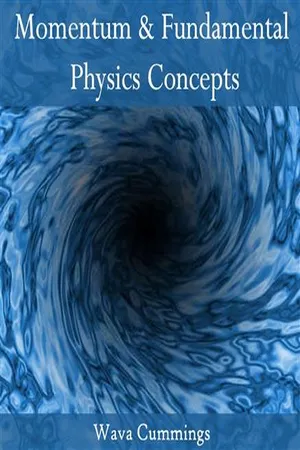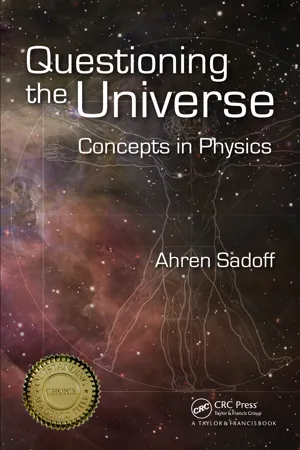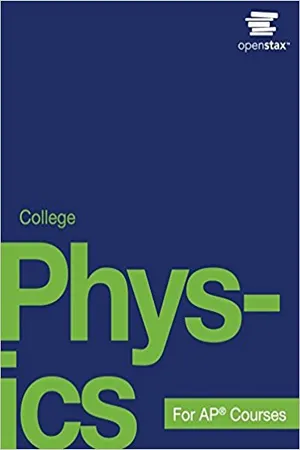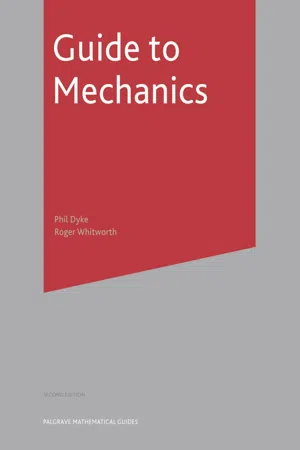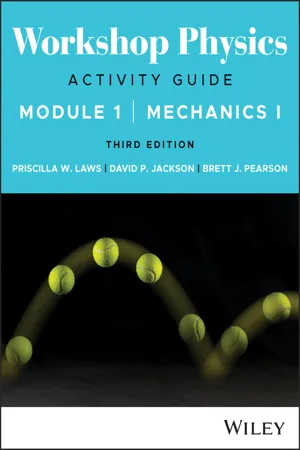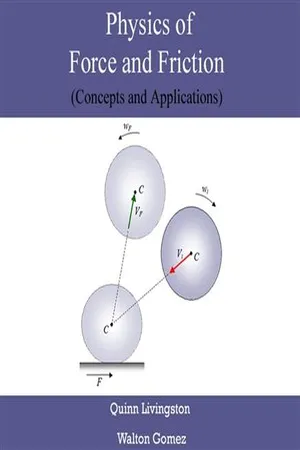Physics
Force
Force is a push or pull that can cause an object to change its speed, direction, or shape. It is a vector quantity, meaning it has both magnitude and direction. Forces can be described using Newton's laws of motion and are measured in units called newtons (N).
Written by Perlego with AI-assistance
Related key terms
1 of 5
11 Key excerpts on "Force"
- No longer available |Learn more
- (Author)
- 2014(Publication Date)
- Academic Studio(Publisher)
________________________ WORLD TECHNOLOGIES ________________________ Chapter 2 Force Forces are also described as a push or pull on an object. They can be due to phenomena such as gravity, magnetism, or anything that might cause a mass to accelerate. Force SI symbol: F SI unit: newton Derivations from other quantities: F = m · a In physics, a Force is any influence that causes a free body to undergo a change in speed, a change in direction, or a change in shape. Force can also be described by intuitive concepts such as a push or pull that can cause an object with mass to change its velocity (which includes to begin moving from a state of rest), i.e., to accelerate, or which can cause a flexible object to deform. A Force has both magnitude and direction, making it a vector quantity. Newton's second law, F=ma, can be formulated to state that an object with a constant mass will accelerate in proportion to the net Force acting upon and in inverse proportion to its mass, an approximation which breaks down near the speed of light. Newton's original formulation is exact, and does not break down: this version states ________________________ WORLD TECHNOLOGIES ________________________ that the net Force acting upon an object is equal to the rate at which its momentum changes. Related concepts to accelerating Forces include thrust, increasing the velocity of the object, drag, decreasing the velocity of any object, and torque, causing changes in rotational speed about an axis. Forces which do not act uniformly on all parts of a body will also cause mechanical stresses, a technical term for influences which cause deformation of matter. While mechanical stress can remain embedded in a solid object, gradually deforming it, mechanical stress in a fluid determines changes in its pressure and volume. - No longer available |Learn more
- (Author)
- 2014(Publication Date)
- Learning Press(Publisher)
________________________ WORLD TECHNOLOGIES ________________________ Chapter- 6 Force Forces are also described as a push or pull on an object. They can be due to phenomena such as gravity, magnetism, or anything else that might cause a mass to accelerate. In physics, a Force is any influence that causes a free body to undergo an acceleration. Force can also be described by intuitive concepts such as a push or pull that can cause an object with mass to change its velocity (which includes to begin moving from a state of rest), i.e., to accelerate, or which can cause a flexible object to deform. A Force has both magnitude and direction, making it a vector quantity. Newton's second law, F=ma, can be formulated to state that an object with a constant mass will accelerate in proportion to the net Force acting upon and in inverse proportion to its mass, an approximation which breaks down near the speed of light. Newton's original formulation is exact, and does not break down: this version states that the net Force acting upon an object is equal to the rate at which its momentum changes. Related concepts to accelerating Forces include thrust, increasing the velocity of the object, drag, decreasing the velocity of any object, and torque, causing changes in rotational speed about an axis. Forces which do not act uniformly on all parts of a body ________________________ WORLD TECHNOLOGIES ________________________ will also cause mechanical stresses, a technical term for influences which cause deformation of matter. While mechanical stress can remain embedded in a solid object, gradually deforming it, mechanical stress in a fluid determines changes in its pressure and volume. - eBook - PDF
Questioning the Universe
Concepts in Physics
- Ahren Sadoff(Author)
- 2008(Publication Date)
- Chapman and Hall/CRC(Publisher)
23 4 Forces 4.1 THE FUNDAMENTAL ForceS What is a Force? One answer is that it is a push or a pull. A better answer, that we will find to be more useful, is that it is an interaction between two or more objects. For most of our discussion, two objects will suffice. Forces are no strangers to us since we interact with all sorts of things every day. Below is a list of Forces I have compiled. Before reading my list, it would be instruc-tive for you to take out a piece of paper and make your own list. Hopefully you will come up with some not on my list. Gravity Electric Weak nuclear Strong nuclear Centrifugal Magnetic Centripetal Friction Wind Force Contact Force (between surfaces) Muscular Force Chemical Atomic I am sure you have noticed that my list is arranged in columns or categories. Let us look at the last column first. Both items are, in fact, not Forces at all, but adjec-tives describing the action of a particular Force. A centrifugal Force is any Force that is directed outward from the center of a curve when an object is traveling in curved motion. Similarly, a centripetal Force acts inward toward the center of the curve. Gravity is usually the Force most people list first, as I have. It, of course, is very important to us since it keeps us bound to the earth and the earth to the sun. The second column contains many familiar Forces under one heading. Why? Because all these seemingly different Forces are all due to only one Force. Electric and magnetic are not separate Forces, but just different manifestations of what is known as the electromagnetic Force (we will discuss this in more detail shortly). The Force that holds the atom together is not some special new Force, but is just due to the electri-cal attraction of the negatively charged electrons to the positively charged protons in the nucleus. Similarly, different atoms interact by the attraction or repulsion of the electrons and protons in one atom acting on the electrons and protons of another atom. - eBook - PDF
- John D. Cutnell, Kenneth W. Johnson, David Young, Shane Stadler(Authors)
- 2015(Publication Date)
- Wiley(Publisher)
4.1 | The Concepts of Force and Mass In common usage, a Force is a push or a pull, as the examples in Figure 4.1 illustrate. In football, an offensive lineman pushes against his opponent. The tow bar attached to a speed- ing boat pulls a water skier. Forces such as those that push against the football player or pull the skier are called contact Forces, because they arise from the physical contact between two objects. There are circumstances, however, in which two objects exert Forces on one another even though they are not touching. Such Forces are referred to as noncontact Forces or action-at-a-distance Forces. One example of such a noncontact Force occurs when a diver is pulled toward the earth because of the Force of gravity. The earth exerts this Force even when it is not in direct contact with the diver. In Figure 4.1, arrows are used to rep- resent the Forces. It is appropriate to use arrows, because a Force is a vector quantity and has both a magnitude and a direction. The direction of the arrow gives the direction of the Force, and the length is proportional to its strength or magnitude. The word mass is just as familiar as the word Force. A massive supertanker, for instance, is one that contains an enormous amount of mass. As we will see in the next section, it is difficult to set such a massive object into motion and difficult to bring it to a halt once it is moving. In comparison, a penny does not contain much mass. The emphasis here is on the amount of mass, and the idea of direction is of no concern. Therefore, mass is a scalar quantity. During the seventeenth century, Isaac Newton, building on the work of Galileo, developed three important laws that deal with Force and mass. Collectively they are called “Newton’s laws of motion” and provide the basis for understanding the effect that Forces have on an object. Because of the importance of these laws, a separate section will be devoted to each one. - eBook - PDF
- John D. Cutnell, Kenneth W. Johnson, David Young, Shane Stadler, Heath Jones, Matthew Collins, John Daicopoulos, Boris Blankleider(Authors)
- 2020(Publication Date)
- Wiley(Publisher)
Forces such as those that push against the football player or pull the skier are called contact Forces, because they arise from the physical contact between two objects. There are circumstances, however, in which two objects exert Forces on one another even though they are not touching. Such Forces are referred to as noncontact Forces or action‐at‐a‐distance Forces. One example of such a noncontact Force occurs when a diver is pulled towards the earth because of the Force of gravity. The earth exerts this Force even when it is not in direct contact with the diver. In figure 4.1, arrows are used to represent the Forces. It is appropriate to use arrows, because a Force is a vector quantity and has both a magnitude and a direction. The direction of the arrow gives the direction of the Force, and the length is proportional to its strength or magnitude. FIGURE 4.1 The arrow labelled F represents the Force that acts on (a) the football player, (b) the water skier, and (c) the cliff diver. F (a ) F Source: Ikon Images / SuperStock ( c) F Source: age fotostock / SuperStock (b) F The word mass is just as familiar as the word Force. A massive supertanker, for instance, is one that contains an enormous amount of mass. As we will see in the next section, it is difficult to set such a massive object into motion and difficult to bring it to a halt once it is moving. In comparison, a penny does not contain much mass. The emphasis here is on the amount of mass, and the idea of direction is of no concern. Therefore, mass is a scalar quantity. During the seventeenth century, Isaac Newton, building on the work of Galileo, developed three important laws that deal with Force and mass. Collectively they are called ‘Newton’s laws of motion’ and provide the basis for understanding the effect that Forces have on an object. Because of the importance of these laws, a separate section will be devoted to each one. - eBook - PDF
- Paul Peter Urone, Roger Hinrichs(Authors)
- 2012(Publication Date)
- Openstax(Publisher)
There is no reason that nature must be simple—it simply is. Action at a Distance: Concept of a Field All Forces act at a distance. This is obvious for the gravitational Force. Earth and the Moon, for example, interact without coming into contact. It is also true for all other Forces. Friction, for example, is an electromagnetic Force between atoms that may not actually touch. What is it that carries Forces between objects? One way to answer this question is to imagine that a Force field surrounds whatever object creates the Force. A second object (often called a test object) placed in this field will experience a Force that is a function of location and other variables. The field itself is the “thing” that carries the Force from one object to another. The field is defined so as to be a characteristic of the object creating it; the field does not depend on the test object placed in it. Earth’s gravitational field, for example, is a function of the mass of Earth and the distance from its center, 1. The graviton is a proposed particle, though it has not yet been observed by scientists. See the discussion of gravitational waves later in this section. The particles W + , W − , and Z 0 are called vector bosons; these were predicted by theory and first observed in 1983. There are eight types of gluons proposed by scientists, and their existence is indicated by meson exchange in the nuclei of atoms. 160 Chapter 4 | Dynamics: Force and Newton's Laws of Motion This OpenStax book is available for free at http://cnx.org/content/col11406/1.9 independent of the presence of other masses. The concept of a field is useful because equations can be written for Force fields surrounding objects (for gravity, this yields w = mg at Earth’s surface), and motions can be calculated from these equations. (See Figure 4.26.) Figure 4.26 The electric Force field between a positively charged particle and a negatively charged particle. - eBook - PDF
- John D. Cutnell, Kenneth W. Johnson, David Young, Shane Stadler(Authors)
- 2018(Publication Date)
- Wiley(Publisher)
In these equations the x and y subscripts refer to the scalar components of the Force and acceler- ation vectors. The SI unit of Force is the newton (N). Σ F → = ma → (4.1) Σ F x = ma x (4.2a) Σ F y = ma y (4.2b) When determining the net Force, a free-body diagram is helpful. A free- body diagram is a diagram that represents the object and the Forces acting on it. 4.5 Newton’s Third Law of Motion Newton’s third law of motion, often called the action–reaction law, states that whenever one object exerts a Force on a second object, the second object exerts an oppositely directed Force of equal magnitude on the first object. 4.6 Types of Forces: An Overview Only three fundamental Forces have been discovered: the gravitational Force, the strong nuclear Force, and the electroweak Force. The electroweak Force manifests itself as either the elec- tromagnetic Force or the weak nuclear Force. 4.7 The Gravitational Force Newton’s law of universal gravitation states that every particle in the universe exerts an attractive Force on every other 112 CHAPTER 4 Forces and Newton’s Laws of Motion particle. For two particles that are separated by a distance r and have masses m 1 and m 2 , the law states that the magnitude of this attractive Force is as given in Equation 4.3. The direction of this Force lies along the line between the particles. The constant G has a value of G = 6.674 × 10 −11 N · m 2 /kg 2 and is called the universal gravitational constant. F = G m 1 m 2 r 2 (4.3) The weight W of an object on or above the earth is the gravitational Force that the earth exerts on the object and can be calculated from the mass m of the object and the magnitude g of the acceleration due to the earth’s gravity, according to Equation 4.5. W = mg (4.5) 4.8 The Normal Force The normal Force F N → is one component of the Force that a surface exerts on an object with which it is in contact—namely, the component that is perpendicular to the surface. - eBook - PDF
- John D. Cutnell, Kenneth W. Johnson, David Young, Shane Stadler(Authors)
- 2021(Publication Date)
- Wiley(Publisher)
Such Forces are referred to as noncontact Forces or action-at-a- distance Forces. One example of such a noncontact Force occurs when 4.2 Newton’s First Law of Motion 87 a diver is pulled toward the earth because of the Force of gravity. The earth exerts this Force even when it is not in direct contact with the diver. In Figure 4.1, arrows are used to represent the Forces. It is appropriate to use arrows, because a Force is a vector quantity and has both a magnitude and a direction. The direction of the arrow gives the direction of the Force, and the length is proportional to its strength or magnitude. The word mass is just as familiar as the word Force. A massive supertanker, for instance, is one that contains an enormous amount of mass. As we will see in the next section, it is difficult to set such a massive object into motion and difficult to bring it to a halt once it is moving. In comparison, a penny does not contain much mass. The empha- sis here is on the amount of mass, and the idea of direction is of no concern. Therefore, mass is a scalar quantity. During the seventeenth century, Isaac Newton, building on the work of Galileo, developed three important laws that deal with Force and mass. Collectively they are called “Newton’s laws of motion” and provide the basis for understanding the effect that Forces have on an object. Because of the importance of these laws, a separate section will be devoted to each one. 4.2 Newton’s First Law of Motion The First Law To gain some insight into Newton’s first law, think about the game of ice hockey (Fig- ure 4.2). If a player does not hit a stationary puck, it will remain at rest on the ice. After the puck is struck, however, it coasts on its own across the ice, slowing down only slightly because of friction. Since ice is very slippery, there is only a relatively small amount of friction to slow down the puck. - eBook - PDF
- Philip Dyke, Roger Whitworth(Authors)
- 2017(Publication Date)
- Red Globe Press(Publisher)
CHAPTER 2 Forces 2.1 Force as a vector We now introduce the concept of Force. When Forces are studied alone, the study is called statics . When they are studies in conjunction with kinematics, then the area of study is called dynamics . If a body changes its velocity, we conclude that a Force acts upon it. Consider the motion of parachutists falling from an airplane: 1 At first, they fall vertically downwards as a result of the Force acting on them in that direction (Figure 2.1(a)). Their speed increases as they move downwards. The vertical Force involved is principally the weight , which is the Force of the Earth's attraction acting on the parachutist. In addition, there are resistance Forces . Resistance Forces will always oppose motion when they occur. 2 After the parachute opens (Figure 2.1(b)), the parachutist's speed will eventually reach a stage when it stops increasing. In this case, the velocity is no longer changing and all the Forces acting on the body must cancel out. In fact, the magnitude of the resistance Force is then equal to the magnitude of the weight (see Chapter 5). In the case of a body in a state of equilibrium , that is, at rest, the total Force acting on the body must also be zero. Consider the following cases of a body P in equilibrium: Resistance Resistance Weight Weight (b) (a) Figure 2.1 Parachutists 27 Tension Weight (a) Reaction Reaction Weight Weight (c) Thrust Weight (b) (d) (e) Normal reaction Friction Push Normal reaction Friction Weight Weight (f) Figure 2.2 Bodies in equilibrium 1 When the body is suspended by a string to hang freely (Figure 2.2(a)), the weight is supported by an upward Force in the string, the tension . 2 When the body is supported on a spring from below (Figure 2.2(b)), the weight is supported by an upward Force in the spring, the thrust . 3 When the body is resting on a horizontal surface, the weight is supported by an upward Force supplied by the surface, the reaction or normal reaction (Figure 2.2(c)). - eBook - PDF
Workshop Physics Activity Guide Module 1
Mechanics I
- Priscilla W. Laws, David P. Jackson, Brett J. Pearson(Authors)
- 2023(Publication Date)
- Wiley(Publisher)
To help avoid this type of confusion, we suggest that the actual Forces are always placed on the left side of the equation. Once all the Forces have been accounted for (and properly added), you then set this net Force equal to m a, which is written on the right side of the equation. We will have much more to say about this in the units to come. Final Comments on Force, Mass, and Motion We started our study of Newtonian dynamics by developing the concept of Force. When asked to define Force, most people initially think of a push or pull, such as the tug of a rubber band. By studying the acceleration that results from a Force when little friction is present, we found a simple relationship between Force and acceleration. However, pushing on a wall doesn’t seem to cause the wall to accelerate. Similarly, an object dropped close to the surface of Earth accelerates, and yet there is no visible push or pull on it. Newton recognized that he could define the net Force as the Force that causes acceleration. He reasoned that if the obvious applied Forces did not account for the observed acceleration, then other “invisible” Forces must be present (Fig. 5.13). A prime example of an invisible Force is that of “gravity,” the attractive Force pulling objects toward Earth. Identifying the Forces acting UNIT 5: Force, MASS, AND MOTION 161 on an object can sometimes be challenging, particularly when some of them are passive Forces. Passive Forces only act in response to either the motion of an object or other Forces acting on the object. For example, pushing on a wall results in a passive Force. Assuming the wall stays put (its acceleration remains zero), the net Force on the wall must be zero. Therefore, if you push on the wall in one direction, there must be some other Force acting on the wall such that the net Force on the wall is zero. Furthermore, this passive Force acting on the wall will “disappear” the instant you stop pushing so that the net Force on the wall remains zero. - No longer available |Learn more
- (Author)
- 2014(Publication Date)
- Academic Studio(Publisher)
For example, consider a system consisting of an object that is being lowered vertically by a string with tension, T, at a constant velocity. The system has a constant velocity and is therefore in equilibrium because the tension in the string (which is pulling up on the object) is equal to the Force of gravity, mg, which is pulling down on the object. ________________________ WORLD TECHNOLOGIES ________________________ System under net Force A system has a net Force when an unbalanced Force is exerted on it, in other words the sum of all Forces is not zero. Acceleration and net Force always exist together. For example consider the same system as above but suppose the object is now being lowered with an increasing velocity downwards (positive acceleration) therefore there exists a net Force somewhere in the system. In this case negative acceleration would indicate that | mg | > | T |. Strings in modern physics String-like objects in relativistic theories, such as the strings used in some models of interactions between quarks, or those used in the modern string theory, also possess tension. These strings are analyzed in terms of their world sheet, and the energy is then typically proportional to the length of the string. As a result, the tension in such strings is independent of the amount of stretching. 4. Pressure Pressure (the symbol: P ) is the Force per unit area applied in a direction perpendicular to the surface of an object. Gauge pressure is the pressure relative to the local atmospheric or ambient pressure. Definition Pressure is an effect which occurs when a Force is applied on a surface. Pressure is the amount of Force acting on a unit area. The symbol of pressure is P . ________________________ WORLD TECHNOLOGIES ________________________ Formula Conjugate variables of thermodynamics Pressure Volume (Stress) (Strain) Temperature Entropy Chemical potential Particle number Mathematically: where: P is the pressure, F is the normal Force, A is the area.
Index pages curate the most relevant extracts from our library of academic textbooks. They’ve been created using an in-house natural language model (NLM), each adding context and meaning to key research topics.

